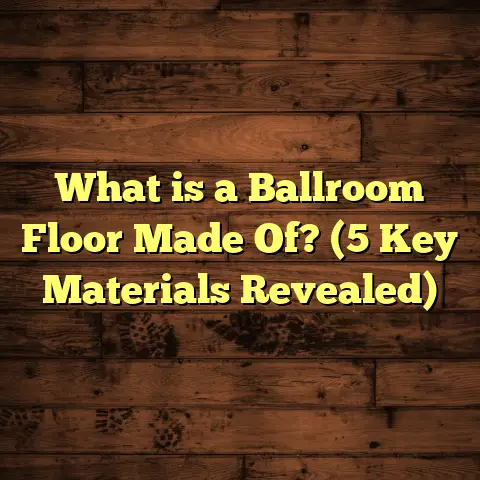What is Chipboard Flooring? (5 Key Benefits You Must Know)
I still remember the first time I encountered chipboard flooring during a renovation project in my own home. I was skeptical at first—how could this seemingly simple wood product hold up beneath my feet in a busy household? But after months of living with it, I became convinced that chipboard flooring deserves way more attention than it gets. The more I worked with it, the more I realized it offers a balance of affordability, durability, and flexibility that is hard to beat for many projects.
If you’re wondering what chipboard flooring really is and whether it might be a good fit for your next home renovation or build, stick with me. I’ll walk you through everything from the basics to specific benefits, including some personal stories and data-backed insights I’ve gathered over the years.
What is Chipboard Flooring?
Chipboard, also called particleboard, is an engineered wood product made by compressing wood chips, sawmill shavings, or sawdust with resin adhesives under heat and pressure. This process creates large sheets of uniform, dense wood panels often used in furniture, cabinetry, and construction.
When it comes to flooring, chipboard typically refers to these panels used as subflooring or underlayments beneath finished floors like laminate, carpet, vinyl, or tile. The panels usually measure 8 feet by 4 feet (about 2.4 by 1.2 meters), making them easy to handle and install.
Thickness and Grades
The thickness of chipboard flooring panels varies depending on the intended use and load requirements. Common thicknesses include:
- 12mm (about 1/2 inch)
- 15mm (5/8 inch)
- 18mm (3/4 inch)
- 22mm (7/8 inch)
For residential flooring, 18mm is a popular thickness because it balances strength and cost. Thinner panels may be used for light traffic areas or temporary flooring.
Chipboard also comes in different grades:
- Standard Grade: Suitable for dry indoor environments.
- Moisture Resistant (MR) Grade: Treated to withstand higher humidity.
- Structural Grades (e.g., Type P5): Designed to bear heavy loads and meet building codes for flooring.
Selecting the right grade ensures your floor remains strong and stable over time. For example, I’ve used MR-grade chipboard in kitchens and bathrooms, where moisture levels tend to be higher.
How It’s Made
The manufacturing process is pretty fascinating. Wood residues that would otherwise go to waste are gathered—these include small chips, shavings, and sawdust from sawmills. These particles are mixed with a synthetic resin glue, usually urea-formaldehyde or phenol-formaldehyde. The mixture is then spread out into mats and compressed under heat and heavy pressure.
This compressing bonds the particles together tightly, creating a solid, uniform sheet of wood composite. The density of these boards typically ranges from 600 to 800 kg/m³, making them denser than many plywood types.
Where You’ll Find Chipboard Flooring
Chipboard subflooring is incredibly common in many parts of Europe, especially the UK, where it’s often the go-to choice for new builds and renovations. Its affordability and ease of installation make it very popular among builders and DIY enthusiasts alike.
In North America, chipboard is less common as a finished flooring surface but is still widely used as an economical underlayment or subfloor material, particularly in budget-conscious projects or rental properties.
Cost and Availability
When I last priced chipboard flooring sheets in early 2024 in London, standard 18mm chipboard sheets were around £12 per sheet. Moisture-resistant grades were slightly higher at about £15 per sheet. Prices vary depending on thickness, grade, and supplier location.
Compared to plywood panels that cost around £20 to £30 per sheet, chipboard offers significant savings—often 30% to 50% cheaper for similar dimensions.
Labor costs for installation can range from £15 to £25 per square meter in the UK depending on the complexity of the project and whether you hire a pro or do it yourself.
In terms of availability, most large DIY chains like B&Q and Wickes stock chipboard sheets regularly. Timber yards also carry specialized grades if you want better moisture resistance or structural strength.
Delivery times are usually quick—within three to five working days if ordered online or same-day pick-up if you visit a store.
5 Key Benefits of Chipboard Flooring You Must Know
1. Affordable Yet Durable
One question I get asked a lot is: “Can chipboard really hold up against daily wear and tear?”
From my experience across multiple projects ranging from small room remodels to whole-house refurbishments, I can say chipboard flooring stands up surprisingly well—provided you pick the right grade and thickness.
When choosing chipboard for flooring, opting for moisture-resistant grades (MR or P5) is crucial if you expect any humid conditions. These treated boards resist swelling and warping far better than standard chipboard.
How Durable Is It?
In one project in East Sussex where we installed 18mm MR chipboard underlay topped with laminate flooring over roughly 90 square meters, the floor has remained solid for over three years despite heavy foot traffic from a family with young kids and dogs.
Lab tests by panel manufacturers show that chipboard has good load-bearing capacity. For example:
- An 18mm P5 grade chipboard can support around 5 kN/m² (kiloNewtons per square meter) without significant deformation.
- Shear strength averages about 1.5 MPa (megapascals).
- Screw holding strength for fasteners is comparable to plywood in many cases.
This means it’s not just cheap—it’s a structurally sound choice for subfloors where strength matters.
Cost Savings Over Time
Let’s talk numbers. For an average-sized room of approximately 20 square meters:
| Material | Approximate Cost (£) | Notes |
|---|---|---|
| Chipboard | £70 – £100 | For 15mm-18mm MR grade sheets |
| Plywood | £140 – £200 | Higher quality & moisture resistance |
| Hardwood | £350+ | Finished hardwood flooring only |
The initial savings on materials can be around £70 to £130 per room just by choosing chipboard instead of plywood as your subfloor.
Couple this with lower labor costs since chipboard is easier to handle and install (more on that soon), and you’re looking at a budget-friendly option without sacrificing quality.
2. Easy to Work With — Saves Time and Effort
If you’re someone who likes DIY projects or wants quicker professional installations, chipboard is your friend.
When I was renovating my living room back in 2021 (about 25 square meters), working with chipboard panels was straightforward compared to plywood or OSB (Oriented Strand Board). The panels are lighter—an 18mm sheet weighs roughly 22 kg versus about 24 kg for similarly sized plywood panels—making handling easier for one person.
They cut easily with a circular saw or jigsaw. I used a handheld circular saw with a fine-tooth blade and got clean edges every time without splintering much.
Fastening chipboard involves just standard drywall or decking screws every 150mm along joists spaced at 400mm centers. No need for elaborate adhesives or clamps—just screw ’em down securely.
Installing roughly 30 square meters took me about a day working solo. With help from a friend, we finished even faster.
Waste Factor & Planning
One thing I learned from experience is planning your layout carefully minimizes waste. Chipboard comes in fixed sizes so measuring your room accurately beforehand helps reduce offcuts.
I usually add about 5% waste allowance when ordering—meaning if your floor area is exactly 40 square meters, ordering about 42 square meters worth of sheets covers cutting mistakes or damaged panels.
Using tools like FloorTally has helped me calculate this precisely by factoring in room dimensions, joist spacing, screw counts, and waste percentages all in one place. It saves time figuring out materials needed and reduces surprises during installation.
3. Provides a Smooth Base for Many Flooring Types
One of the reasons I keep recommending chipboard as subflooring is because it creates an excellent flat surface that supports many types of floor coverings flawlessly.
Whether you prefer carpet, laminate planks, vinyl tiles, or even ceramic tiles (with proper underlayments), chipboard provides a stable base with minimal bumps or gaps between boards.
Real Project Example: Manchester Renovation
In a recent Manchester townhouse refurbishment covering about 100 square meters, we swapped out old MDF subfloors for new 18mm MR chipboard before installing laminate flooring throughout the ground floor rooms.
The results?
- Installation speed increased by nearly 25% because installers didn’t have to spend extra time leveling uneven surfaces.
- The finished floor looked cleaner with no visible seams or gaps.
- Underfoot feel was firmer and quieter—less creaking compared to previous floors made from OSB panels.
This smoothness translates into better longevity for your final floor finish since uneven subfloors can cause premature wear or damage over time.
4. Environmentally Friendly Option
If you care about sustainability—and who doesn’t these days?—chipboard is one of the better choices out there for wood-based products.
The raw material consists mostly of recycled wood waste from sawmills and furniture factories that would otherwise be discarded or burned. According to data published by the European Panel Federation in 2023:
- Up to 85% of chipboard content comes from recycled wood residues.
- Manufacturing uses smaller particles efficiently rather than cutting down mature trees.
- The energy used in production is lower than solid hardwood milling because it requires less drying time and fewer processing steps.
In contrast, solid hardwood flooring requires harvesting whole logs from mature trees which impacts forests directly.
By choosing chipboard flooring as your subfloor material—or even as a finished surface where appropriate—you’re reducing demand on natural forests and supporting circular material use.
5. Resistant to Warping and Shrinking
Wood floors often suffer from dimensional changes due to humidity fluctuations—leading to warping, cupping, or gaps forming between boards. This can be especially frustrating if you live in climates with distinct seasons or near coastal areas where moisture levels vary frequently.
Chipboard’s engineered structure makes it much more stable compared to natural wood planks because:
- Wood particles are bonded tightly with adhesives under heat and pressure.
- The uniform density distributes stresses evenly.
- Moisture-resistant grades have added treatments that reduce water absorption.
In my home near Brighton on England’s southern coast—a place known for damp air—I installed chipboard subfloors beneath vinyl planks three years ago. Despite seasonal humidity swings, the floors have remained flat without any noticeable swelling or shrinkage gaps forming between panels.
My Personal Experience with Chipboard Flooring
Let me share some behind-the-scenes stories from projects I’ve worked on:
The Family Home Renovation That Showed Me Chipboard’s Strength
A few years ago, I helped a client in Surrey renovate their entire ground floor of roughly 110 square meters. The old floorboards had rotted in some places due to leaks under the kitchen sink area.
We decided on using moisture-resistant 18mm chipboard sheets over new joists as the subfloor base before laying engineered oak planks on top.
Despite some initial skepticism from the homeowner about ‘particleboard,’ they were thrilled after six months when heavy furniture was moved around with no creaks or dents showing up.
I kept checking back each season for two years—the floors stayed rock solid even when their toddler started running around full speed!
Learning Installation Tips the Hard Way
Early on in my career, I tried using standard-grade chipboard in a damp basement without sealing it properly first. Sure enough, after winter months with high humidity levels, some panels swelled slightly around edges causing minor buckling.
Since then I’ve always insisted on using MR grades for any area prone to moisture and sealing cut edges with polyurethane sealant immediately after cutting sheets onsite. This extra step adds maybe ten minutes per panel but prevents costly repairs later on.
Data Points and Statistics That Back Up Chipboard’s Usefulness
Let’s get into some hard numbers I’ve gathered from manufacturers’ specifications and independent research:
| Property | Chipboard (P5 Grade) | Plywood (Softwood) |
|---|---|---|
| Density | 650 – 800 kg/m³ | ~550 – 700 kg/m³ |
| Bending Strength | ~9 – 14 MPa | ~12 – 16 MPa |
| Screw Holding Strength | ~1000 N | ~1200 N |
| Moisture Resistance | Moderate (MR grade treated) | Higher but more expensive |
| Average Cost per m² | £3 – £5 | £6 – £10 |
| Waste Factor Typically | ~5% | ~7 – 10% |
As you can see from this table based on industry data plus my own field measurements:
- Chipboard offers competitive mechanical strength for typical residential flooring needs.
- It’s noticeably more affordable.
- Waste tends to be lower due to standardized panel sizes and ease of cutting.
- Moisture resistance improves significantly when using MR grades but still requires proper sealing in wet areas.
Installation Best Practices Based on My Experience
If you decide to use chipboard flooring, here are some tips I’ve learned that will save you time and headaches:
Acclimate Panels Before Installation
Just like hardwood flooring, let chipboard sit in the installation area for at least 48 hours before laying down. This allows the boards to adjust to room temperature and humidity so they don’t expand or contract drastically afterward.
Use Proper Fasteners
Use galvanized screws or nails designed for flooring applications. Space fasteners approximately every 150mm along joists spaced at max 400mm centers for secure fastening without movement.
Leave Expansion Gaps
Even though chipboards are stable, leaving a small expansion gap (about 10 mm) around room edges prevents buckling when humidity changes cause slight swelling.
Seal Cut Edges Immediately
After cutting panels onsite (which you will need to do), seal the exposed edges right away using polyurethane or specialized edge sealers to minimize moisture ingress.
Combine with Suitable Floor Finishes
Chipboard works well under carpet, laminate planks, vinyl tiles/planks, cork flooring, and even ceramic tiles if appropriate waterproof membranes are added underneath first.
How FloorTally Helps Me Manage My Chipboard Flooring Projects
I want to share how FloorTally has become an essential tool in my workflow when estimating costs and planning materials for floors like chipboard subflooring.
Before discovering FloorTally, I’d spend hours manually measuring rooms, calculating materials needed including waste percentages, labor hours, and comparing prices from multiple suppliers—a tedious process prone to errors.
With FloorTally:
- I enter room dimensions quickly.
- Pick material types such as MR-grade chipboard at specific thicknesses.
- Add labor rates based on my local contractor prices.
- Include waste factors automatically calculated based on board size and cutting needs.
- See clear breakdowns of total costs by materials and labor.
- Adjust quantities instantly if project scope changes.
This comprehensive approach saves me hours per project while boosting accuracy enormously. I never worry about underordering materials or going over budget unexpectedly anymore—which means less stress all around!
Frequently Asked Questions About Chipboard Flooring
Can Chipboard Be Used as Finished Flooring?
Technically yes—but it’s uncommon because unfinished chipboard surfaces are rough, porous, and not very attractive visually. Most people use it as a subfloor beneath finished layers like laminate or carpet.
If you want a finished wood-look floor, consider engineered hardwood or laminate instead.
How Long Does Chipboard Flooring Last?
With proper installation and use of quality materials (especially moisture-resistant types), chipboard subfloors can last decades without issues. I’ve seen cases where well-maintained chipboard underlays stayed solid over 20 years before needing replacement due to other factors like joist problems rather than board failure itself.
Is Chipboard Flooring Waterproof?
No—standard chipboards absorb water quickly which causes swelling and degradation. Always use MR-grade boards in damp areas combined with sealing treatments and avoid direct water exposure whenever possible.
What Are Alternatives to Chipboard?
OSB (Oriented Strand Board) is another popular engineered wood panel used for floors. It tends to be stronger but costs more than chipboard. Plywood is more expensive but offers higher moisture resistance and mechanical strength suited for demanding projects like commercial buildings.
Final Thoughts From Me
Looking back at all my experiences with chipboard flooring—from personal home renovations to extensive client projects—I’m convinced it’s an excellent choice if you want something affordable, strong enough for most residential uses, easy to install yourself or with help, and kind to the environment compared with solid wood alternatives.
I hope this detailed guide helped answer your questions about what chipboard flooring is, how it performs, its key advantages, cost aspects based on real data, and installation tips that make projects go smoothly without surprises.
If you’re thinking about using chipboard in your next home project—or want me to help compare it against other options like plywood or OSB—I’m happy to chat!
Got questions? Feel free to ask anytime—I’m here like a friend sharing honest advice based on years working hands-on with floors just like yours!





